Chronic Kidney Disease: Understanding the Disease and Patient Care
VerifiedAdded on 2022/11/29
|7
|2605
|251
Report
AI Summary
This report provides a comprehensive overview of chronic kidney disease (CKD). It begins with an introduction defining CKD and its impact on individuals, highlighting the importance of early detection and treatment to prevent kidney failure. The report explores the causes of CKD, including high blood pressure and diabetes, and discusses the physiological characteristics of the renal structure, including glomerular filtration and its role in the disease's progression. It then delves into the effects of CKD on family dynamics and the support systems available to patients, including healthcare professionals and social workers. The report outlines the signs and symptoms of kidney diseases, such as fatigue, swelling, and concentration problems, and emphasizes the global health concern that CKD poses. It discusses health promotion strategies, particularly the role of nurses in patient care, including creating positive relationships, supporting patients in social settings, and promoting physical activity. The report also touches on cultural safety, dialysis, and patient education, concluding with a call to action to promote cultural safety and prevent discrimination in healthcare. The report underscores the importance of patient empowerment, self-care, and education in managing CKD.
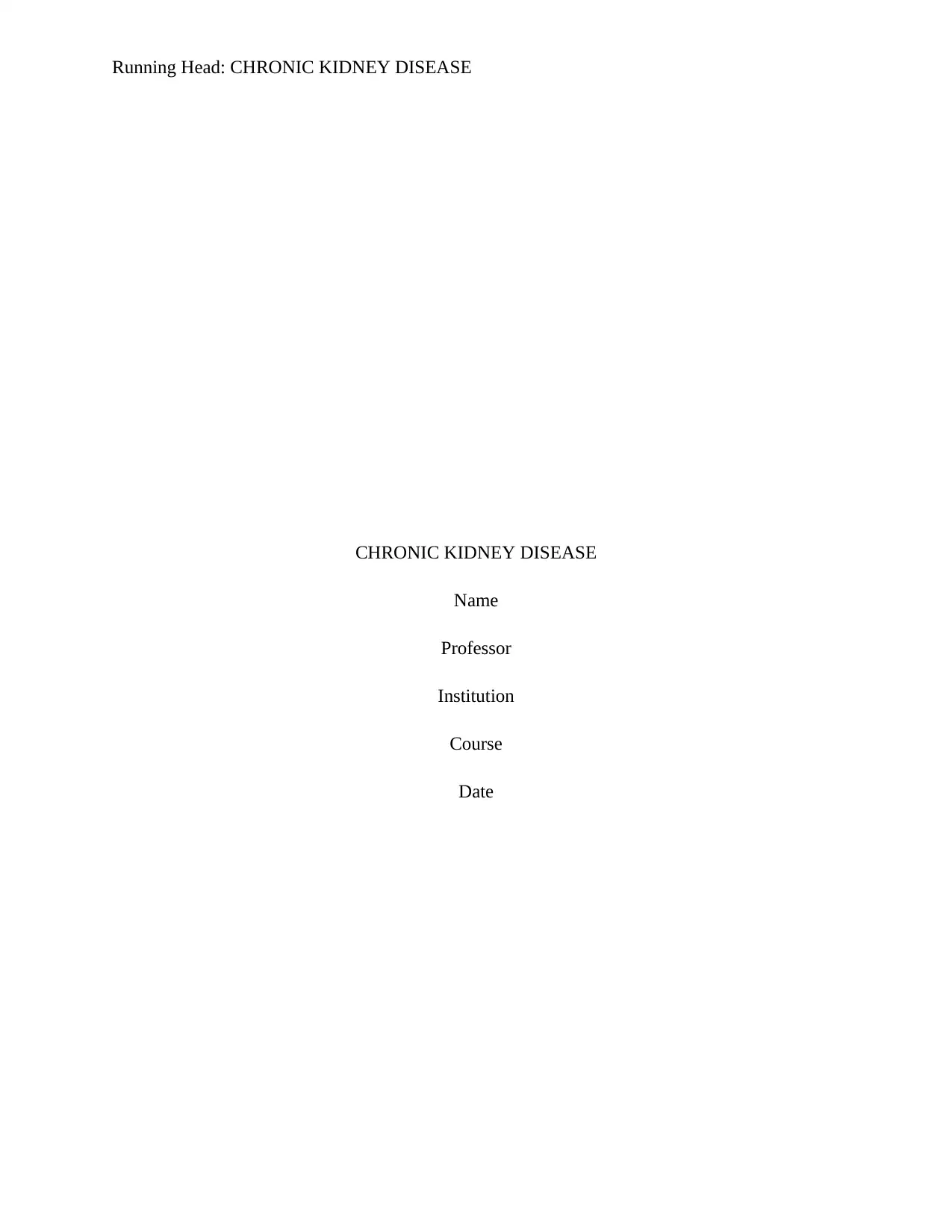
Running Head: CHRONIC KIDNEY DISEASE
CHRONIC KIDNEY DISEASE
Name
Professor
Institution
Course
Date
CHRONIC KIDNEY DISEASE
Name
Professor
Institution
Course
Date
Paraphrase This Document
Need a fresh take? Get an instant paraphrase of this document with our AI Paraphraser
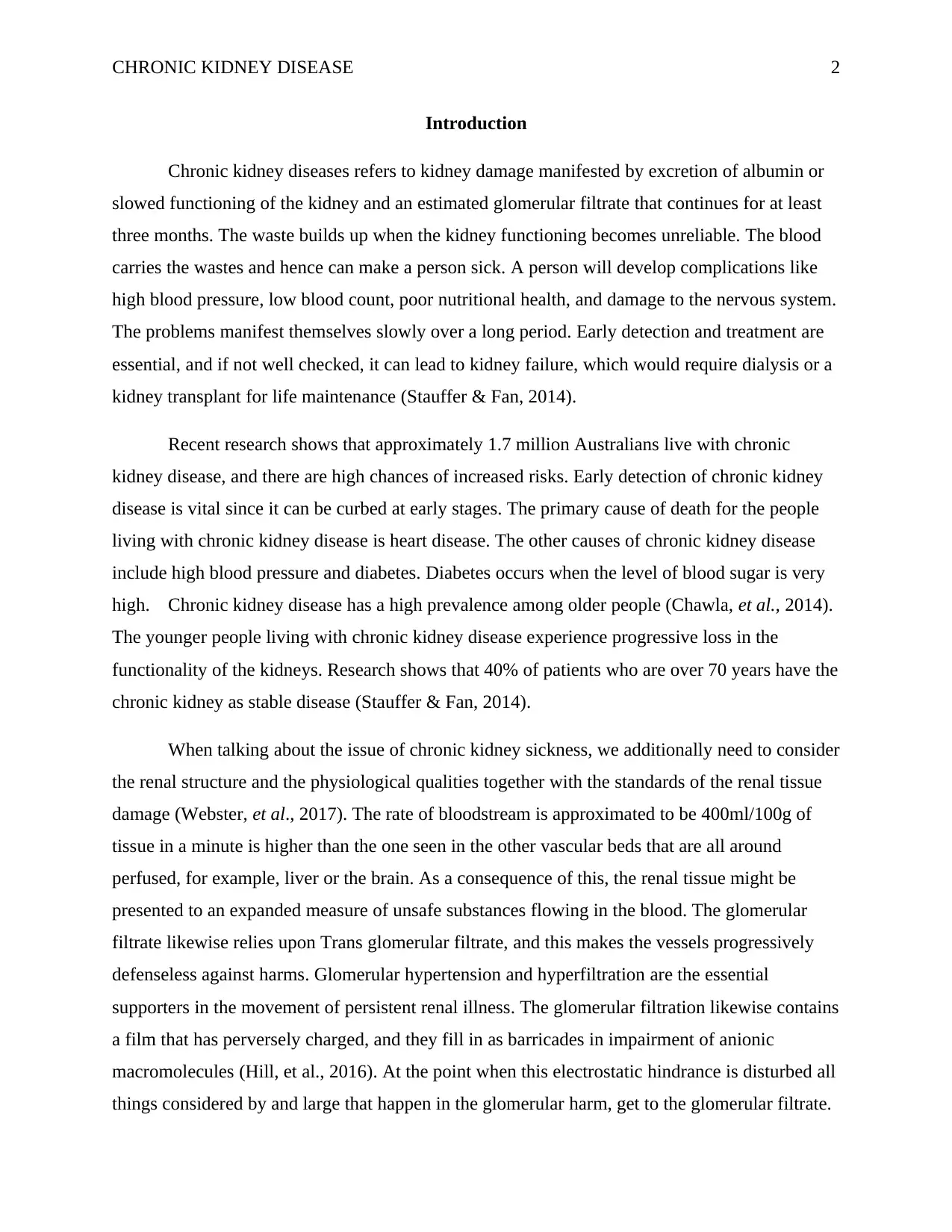
CHRONIC KIDNEY DISEASE 2
Introduction
Chronic kidney diseases refers to kidney damage manifested by excretion of albumin or
slowed functioning of the kidney and an estimated glomerular filtrate that continues for at least
three months. The waste builds up when the kidney functioning becomes unreliable. The blood
carries the wastes and hence can make a person sick. A person will develop complications like
high blood pressure, low blood count, poor nutritional health, and damage to the nervous system.
The problems manifest themselves slowly over a long period. Early detection and treatment are
essential, and if not well checked, it can lead to kidney failure, which would require dialysis or a
kidney transplant for life maintenance (Stauffer & Fan, 2014).
Recent research shows that approximately 1.7 million Australians live with chronic
kidney disease, and there are high chances of increased risks. Early detection of chronic kidney
disease is vital since it can be curbed at early stages. The primary cause of death for the people
living with chronic kidney disease is heart disease. The other causes of chronic kidney disease
include high blood pressure and diabetes. Diabetes occurs when the level of blood sugar is very
high. Chronic kidney disease has a high prevalence among older people (Chawla, et al., 2014).
The younger people living with chronic kidney disease experience progressive loss in the
functionality of the kidneys. Research shows that 40% of patients who are over 70 years have the
chronic kidney as stable disease (Stauffer & Fan, 2014).
When talking about the issue of chronic kidney sickness, we additionally need to consider
the renal structure and the physiological qualities together with the standards of the renal tissue
damage (Webster, et al., 2017). The rate of bloodstream is approximated to be 400ml/100g of
tissue in a minute is higher than the one seen in the other vascular beds that are all around
perfused, for example, liver or the brain. As a consequence of this, the renal tissue might be
presented to an expanded measure of unsafe substances flowing in the blood. The glomerular
filtrate likewise relies upon Trans glomerular filtrate, and this makes the vessels progressively
defenseless against harms. Glomerular hypertension and hyperfiltration are the essential
supporters in the movement of persistent renal illness. The glomerular filtration likewise contains
a film that has perversely charged, and they fill in as barricades in impairment of anionic
macromolecules (Hill, et al., 2016). At the point when this electrostatic hindrance is disturbed all
things considered by and large that happen in the glomerular harm, get to the glomerular filtrate.
Introduction
Chronic kidney diseases refers to kidney damage manifested by excretion of albumin or
slowed functioning of the kidney and an estimated glomerular filtrate that continues for at least
three months. The waste builds up when the kidney functioning becomes unreliable. The blood
carries the wastes and hence can make a person sick. A person will develop complications like
high blood pressure, low blood count, poor nutritional health, and damage to the nervous system.
The problems manifest themselves slowly over a long period. Early detection and treatment are
essential, and if not well checked, it can lead to kidney failure, which would require dialysis or a
kidney transplant for life maintenance (Stauffer & Fan, 2014).
Recent research shows that approximately 1.7 million Australians live with chronic
kidney disease, and there are high chances of increased risks. Early detection of chronic kidney
disease is vital since it can be curbed at early stages. The primary cause of death for the people
living with chronic kidney disease is heart disease. The other causes of chronic kidney disease
include high blood pressure and diabetes. Diabetes occurs when the level of blood sugar is very
high. Chronic kidney disease has a high prevalence among older people (Chawla, et al., 2014).
The younger people living with chronic kidney disease experience progressive loss in the
functionality of the kidneys. Research shows that 40% of patients who are over 70 years have the
chronic kidney as stable disease (Stauffer & Fan, 2014).
When talking about the issue of chronic kidney sickness, we additionally need to consider
the renal structure and the physiological qualities together with the standards of the renal tissue
damage (Webster, et al., 2017). The rate of bloodstream is approximated to be 400ml/100g of
tissue in a minute is higher than the one seen in the other vascular beds that are all around
perfused, for example, liver or the brain. As a consequence of this, the renal tissue might be
presented to an expanded measure of unsafe substances flowing in the blood. The glomerular
filtrate likewise relies upon Trans glomerular filtrate, and this makes the vessels progressively
defenseless against harms. Glomerular hypertension and hyperfiltration are the essential
supporters in the movement of persistent renal illness. The glomerular filtration likewise contains
a film that has perversely charged, and they fill in as barricades in impairment of anionic
macromolecules (Hill, et al., 2016). At the point when this electrostatic hindrance is disturbed all
things considered by and large that happen in the glomerular harm, get to the glomerular filtrate.
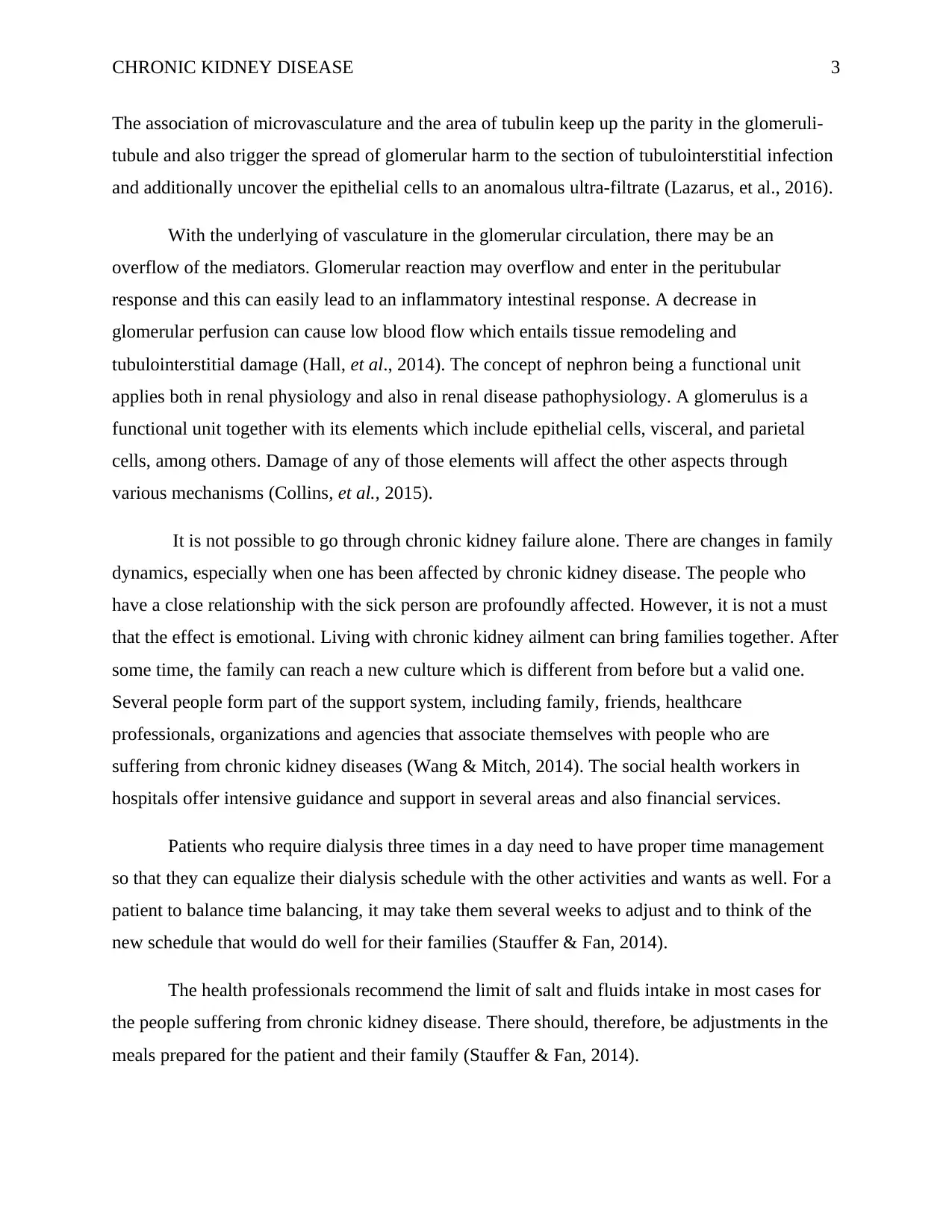
CHRONIC KIDNEY DISEASE 3
The association of microvasculature and the area of tubulin keep up the parity in the glomeruli-
tubule and also trigger the spread of glomerular harm to the section of tubulointerstitial infection
and additionally uncover the epithelial cells to an anomalous ultra-filtrate (Lazarus, et al., 2016).
With the underlying of vasculature in the glomerular circulation, there may be an
overflow of the mediators. Glomerular reaction may overflow and enter in the peritubular
response and this can easily lead to an inflammatory intestinal response. A decrease in
glomerular perfusion can cause low blood flow which entails tissue remodeling and
tubulointerstitial damage (Hall, et al., 2014). The concept of nephron being a functional unit
applies both in renal physiology and also in renal disease pathophysiology. A glomerulus is a
functional unit together with its elements which include epithelial cells, visceral, and parietal
cells, among others. Damage of any of those elements will affect the other aspects through
various mechanisms (Collins, et al., 2015).
It is not possible to go through chronic kidney failure alone. There are changes in family
dynamics, especially when one has been affected by chronic kidney disease. The people who
have a close relationship with the sick person are profoundly affected. However, it is not a must
that the effect is emotional. Living with chronic kidney ailment can bring families together. After
some time, the family can reach a new culture which is different from before but a valid one.
Several people form part of the support system, including family, friends, healthcare
professionals, organizations and agencies that associate themselves with people who are
suffering from chronic kidney diseases (Wang & Mitch, 2014). The social health workers in
hospitals offer intensive guidance and support in several areas and also financial services.
Patients who require dialysis three times in a day need to have proper time management
so that they can equalize their dialysis schedule with the other activities and wants as well. For a
patient to balance time balancing, it may take them several weeks to adjust and to think of the
new schedule that would do well for their families (Stauffer & Fan, 2014).
The health professionals recommend the limit of salt and fluids intake in most cases for
the people suffering from chronic kidney disease. There should, therefore, be adjustments in the
meals prepared for the patient and their family (Stauffer & Fan, 2014).
The association of microvasculature and the area of tubulin keep up the parity in the glomeruli-
tubule and also trigger the spread of glomerular harm to the section of tubulointerstitial infection
and additionally uncover the epithelial cells to an anomalous ultra-filtrate (Lazarus, et al., 2016).
With the underlying of vasculature in the glomerular circulation, there may be an
overflow of the mediators. Glomerular reaction may overflow and enter in the peritubular
response and this can easily lead to an inflammatory intestinal response. A decrease in
glomerular perfusion can cause low blood flow which entails tissue remodeling and
tubulointerstitial damage (Hall, et al., 2014). The concept of nephron being a functional unit
applies both in renal physiology and also in renal disease pathophysiology. A glomerulus is a
functional unit together with its elements which include epithelial cells, visceral, and parietal
cells, among others. Damage of any of those elements will affect the other aspects through
various mechanisms (Collins, et al., 2015).
It is not possible to go through chronic kidney failure alone. There are changes in family
dynamics, especially when one has been affected by chronic kidney disease. The people who
have a close relationship with the sick person are profoundly affected. However, it is not a must
that the effect is emotional. Living with chronic kidney ailment can bring families together. After
some time, the family can reach a new culture which is different from before but a valid one.
Several people form part of the support system, including family, friends, healthcare
professionals, organizations and agencies that associate themselves with people who are
suffering from chronic kidney diseases (Wang & Mitch, 2014). The social health workers in
hospitals offer intensive guidance and support in several areas and also financial services.
Patients who require dialysis three times in a day need to have proper time management
so that they can equalize their dialysis schedule with the other activities and wants as well. For a
patient to balance time balancing, it may take them several weeks to adjust and to think of the
new schedule that would do well for their families (Stauffer & Fan, 2014).
The health professionals recommend the limit of salt and fluids intake in most cases for
the people suffering from chronic kidney disease. There should, therefore, be adjustments in the
meals prepared for the patient and their family (Stauffer & Fan, 2014).
⊘ This is a preview!⊘
Do you want full access?
Subscribe today to unlock all pages.

Trusted by 1+ million students worldwide
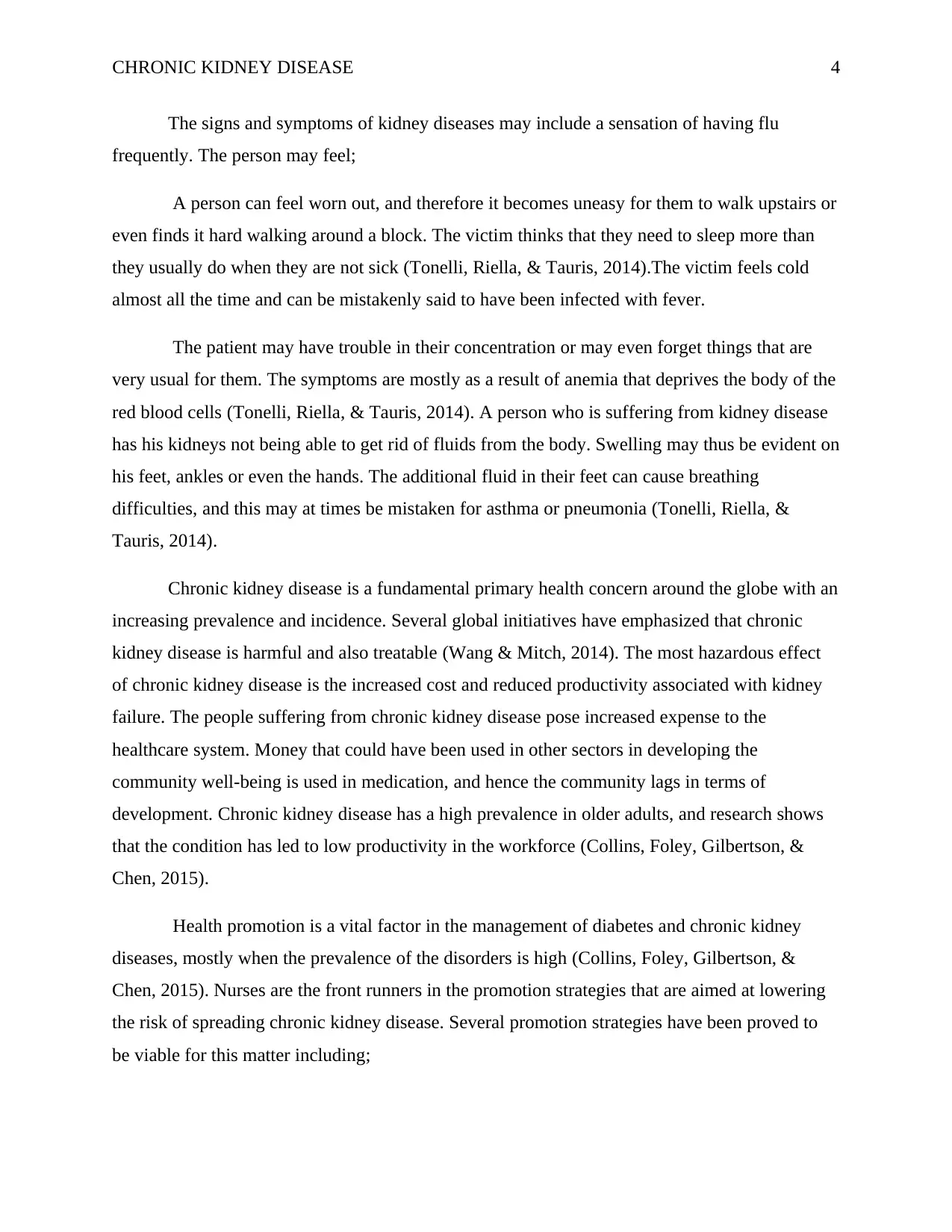
CHRONIC KIDNEY DISEASE 4
The signs and symptoms of kidney diseases may include a sensation of having flu
frequently. The person may feel;
A person can feel worn out, and therefore it becomes uneasy for them to walk upstairs or
even finds it hard walking around a block. The victim thinks that they need to sleep more than
they usually do when they are not sick (Tonelli, Riella, & Tauris, 2014).The victim feels cold
almost all the time and can be mistakenly said to have been infected with fever.
The patient may have trouble in their concentration or may even forget things that are
very usual for them. The symptoms are mostly as a result of anemia that deprives the body of the
red blood cells (Tonelli, Riella, & Tauris, 2014). A person who is suffering from kidney disease
has his kidneys not being able to get rid of fluids from the body. Swelling may thus be evident on
his feet, ankles or even the hands. The additional fluid in their feet can cause breathing
difficulties, and this may at times be mistaken for asthma or pneumonia (Tonelli, Riella, &
Tauris, 2014).
Chronic kidney disease is a fundamental primary health concern around the globe with an
increasing prevalence and incidence. Several global initiatives have emphasized that chronic
kidney disease is harmful and also treatable (Wang & Mitch, 2014). The most hazardous effect
of chronic kidney disease is the increased cost and reduced productivity associated with kidney
failure. The people suffering from chronic kidney disease pose increased expense to the
healthcare system. Money that could have been used in other sectors in developing the
community well-being is used in medication, and hence the community lags in terms of
development. Chronic kidney disease has a high prevalence in older adults, and research shows
that the condition has led to low productivity in the workforce (Collins, Foley, Gilbertson, &
Chen, 2015).
Health promotion is a vital factor in the management of diabetes and chronic kidney
diseases, mostly when the prevalence of the disorders is high (Collins, Foley, Gilbertson, &
Chen, 2015). Nurses are the front runners in the promotion strategies that are aimed at lowering
the risk of spreading chronic kidney disease. Several promotion strategies have been proved to
be viable for this matter including;
The signs and symptoms of kidney diseases may include a sensation of having flu
frequently. The person may feel;
A person can feel worn out, and therefore it becomes uneasy for them to walk upstairs or
even finds it hard walking around a block. The victim thinks that they need to sleep more than
they usually do when they are not sick (Tonelli, Riella, & Tauris, 2014).The victim feels cold
almost all the time and can be mistakenly said to have been infected with fever.
The patient may have trouble in their concentration or may even forget things that are
very usual for them. The symptoms are mostly as a result of anemia that deprives the body of the
red blood cells (Tonelli, Riella, & Tauris, 2014). A person who is suffering from kidney disease
has his kidneys not being able to get rid of fluids from the body. Swelling may thus be evident on
his feet, ankles or even the hands. The additional fluid in their feet can cause breathing
difficulties, and this may at times be mistaken for asthma or pneumonia (Tonelli, Riella, &
Tauris, 2014).
Chronic kidney disease is a fundamental primary health concern around the globe with an
increasing prevalence and incidence. Several global initiatives have emphasized that chronic
kidney disease is harmful and also treatable (Wang & Mitch, 2014). The most hazardous effect
of chronic kidney disease is the increased cost and reduced productivity associated with kidney
failure. The people suffering from chronic kidney disease pose increased expense to the
healthcare system. Money that could have been used in other sectors in developing the
community well-being is used in medication, and hence the community lags in terms of
development. Chronic kidney disease has a high prevalence in older adults, and research shows
that the condition has led to low productivity in the workforce (Collins, Foley, Gilbertson, &
Chen, 2015).
Health promotion is a vital factor in the management of diabetes and chronic kidney
diseases, mostly when the prevalence of the disorders is high (Collins, Foley, Gilbertson, &
Chen, 2015). Nurses are the front runners in the promotion strategies that are aimed at lowering
the risk of spreading chronic kidney disease. Several promotion strategies have been proved to
be viable for this matter including;
Paraphrase This Document
Need a fresh take? Get an instant paraphrase of this document with our AI Paraphraser
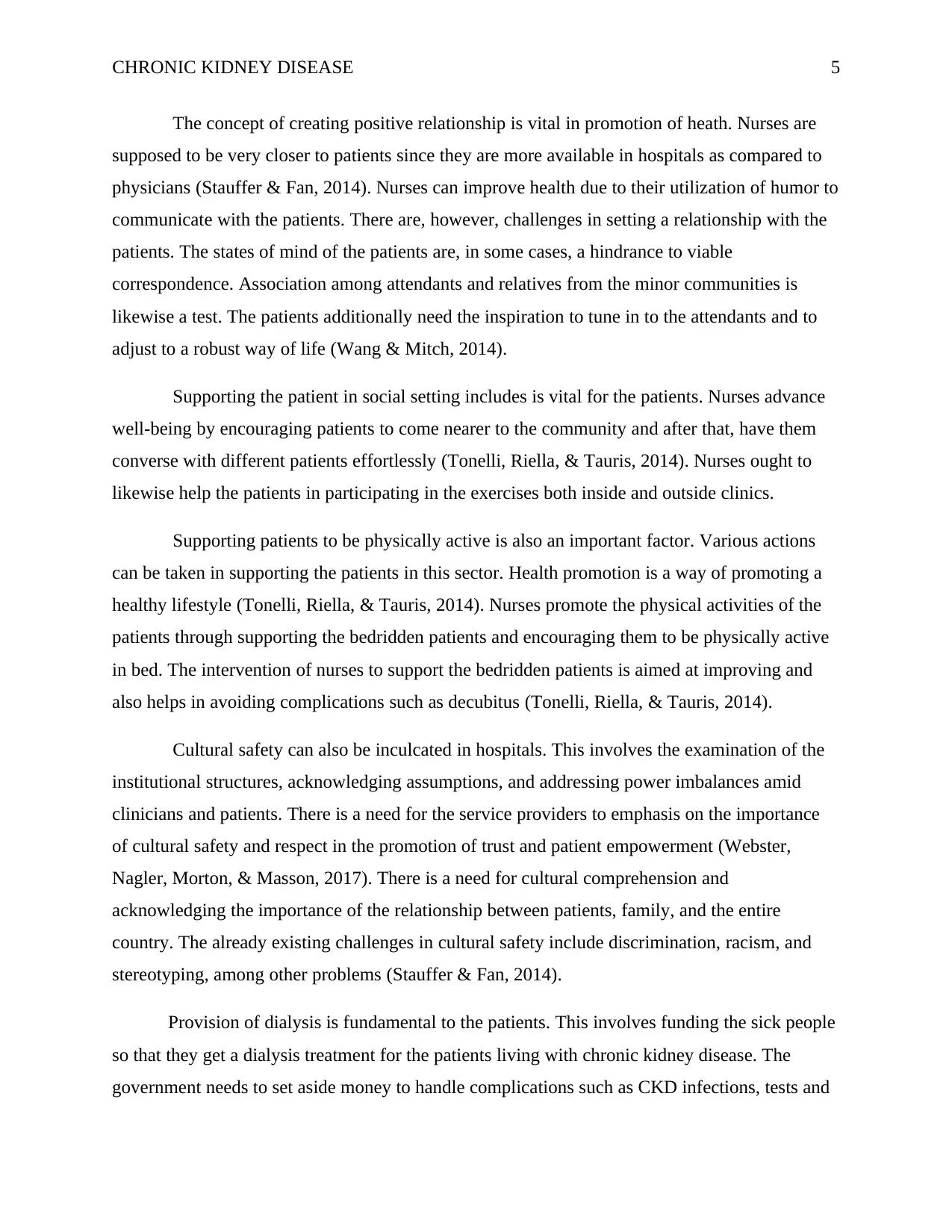
CHRONIC KIDNEY DISEASE 5
The concept of creating positive relationship is vital in promotion of heath. Nurses are
supposed to be very closer to patients since they are more available in hospitals as compared to
physicians (Stauffer & Fan, 2014). Nurses can improve health due to their utilization of humor to
communicate with the patients. There are, however, challenges in setting a relationship with the
patients. The states of mind of the patients are, in some cases, a hindrance to viable
correspondence. Association among attendants and relatives from the minor communities is
likewise a test. The patients additionally need the inspiration to tune in to the attendants and to
adjust to a robust way of life (Wang & Mitch, 2014).
Supporting the patient in social setting includes is vital for the patients. Nurses advance
well-being by encouraging patients to come nearer to the community and after that, have them
converse with different patients effortlessly (Tonelli, Riella, & Tauris, 2014). Nurses ought to
likewise help the patients in participating in the exercises both inside and outside clinics.
Supporting patients to be physically active is also an important factor. Various actions
can be taken in supporting the patients in this sector. Health promotion is a way of promoting a
healthy lifestyle (Tonelli, Riella, & Tauris, 2014). Nurses promote the physical activities of the
patients through supporting the bedridden patients and encouraging them to be physically active
in bed. The intervention of nurses to support the bedridden patients is aimed at improving and
also helps in avoiding complications such as decubitus (Tonelli, Riella, & Tauris, 2014).
Cultural safety can also be inculcated in hospitals. This involves the examination of the
institutional structures, acknowledging assumptions, and addressing power imbalances amid
clinicians and patients. There is a need for the service providers to emphasis on the importance
of cultural safety and respect in the promotion of trust and patient empowerment (Webster,
Nagler, Morton, & Masson, 2017). There is a need for cultural comprehension and
acknowledging the importance of the relationship between patients, family, and the entire
country. The already existing challenges in cultural safety include discrimination, racism, and
stereotyping, among other problems (Stauffer & Fan, 2014).
Provision of dialysis is fundamental to the patients. This involves funding the sick people
so that they get a dialysis treatment for the patients living with chronic kidney disease. The
government needs to set aside money to handle complications such as CKD infections, tests and
The concept of creating positive relationship is vital in promotion of heath. Nurses are
supposed to be very closer to patients since they are more available in hospitals as compared to
physicians (Stauffer & Fan, 2014). Nurses can improve health due to their utilization of humor to
communicate with the patients. There are, however, challenges in setting a relationship with the
patients. The states of mind of the patients are, in some cases, a hindrance to viable
correspondence. Association among attendants and relatives from the minor communities is
likewise a test. The patients additionally need the inspiration to tune in to the attendants and to
adjust to a robust way of life (Wang & Mitch, 2014).
Supporting the patient in social setting includes is vital for the patients. Nurses advance
well-being by encouraging patients to come nearer to the community and after that, have them
converse with different patients effortlessly (Tonelli, Riella, & Tauris, 2014). Nurses ought to
likewise help the patients in participating in the exercises both inside and outside clinics.
Supporting patients to be physically active is also an important factor. Various actions
can be taken in supporting the patients in this sector. Health promotion is a way of promoting a
healthy lifestyle (Tonelli, Riella, & Tauris, 2014). Nurses promote the physical activities of the
patients through supporting the bedridden patients and encouraging them to be physically active
in bed. The intervention of nurses to support the bedridden patients is aimed at improving and
also helps in avoiding complications such as decubitus (Tonelli, Riella, & Tauris, 2014).
Cultural safety can also be inculcated in hospitals. This involves the examination of the
institutional structures, acknowledging assumptions, and addressing power imbalances amid
clinicians and patients. There is a need for the service providers to emphasis on the importance
of cultural safety and respect in the promotion of trust and patient empowerment (Webster,
Nagler, Morton, & Masson, 2017). There is a need for cultural comprehension and
acknowledging the importance of the relationship between patients, family, and the entire
country. The already existing challenges in cultural safety include discrimination, racism, and
stereotyping, among other problems (Stauffer & Fan, 2014).
Provision of dialysis is fundamental to the patients. This involves funding the sick people
so that they get a dialysis treatment for the patients living with chronic kidney disease. The
government needs to set aside money to handle complications such as CKD infections, tests and
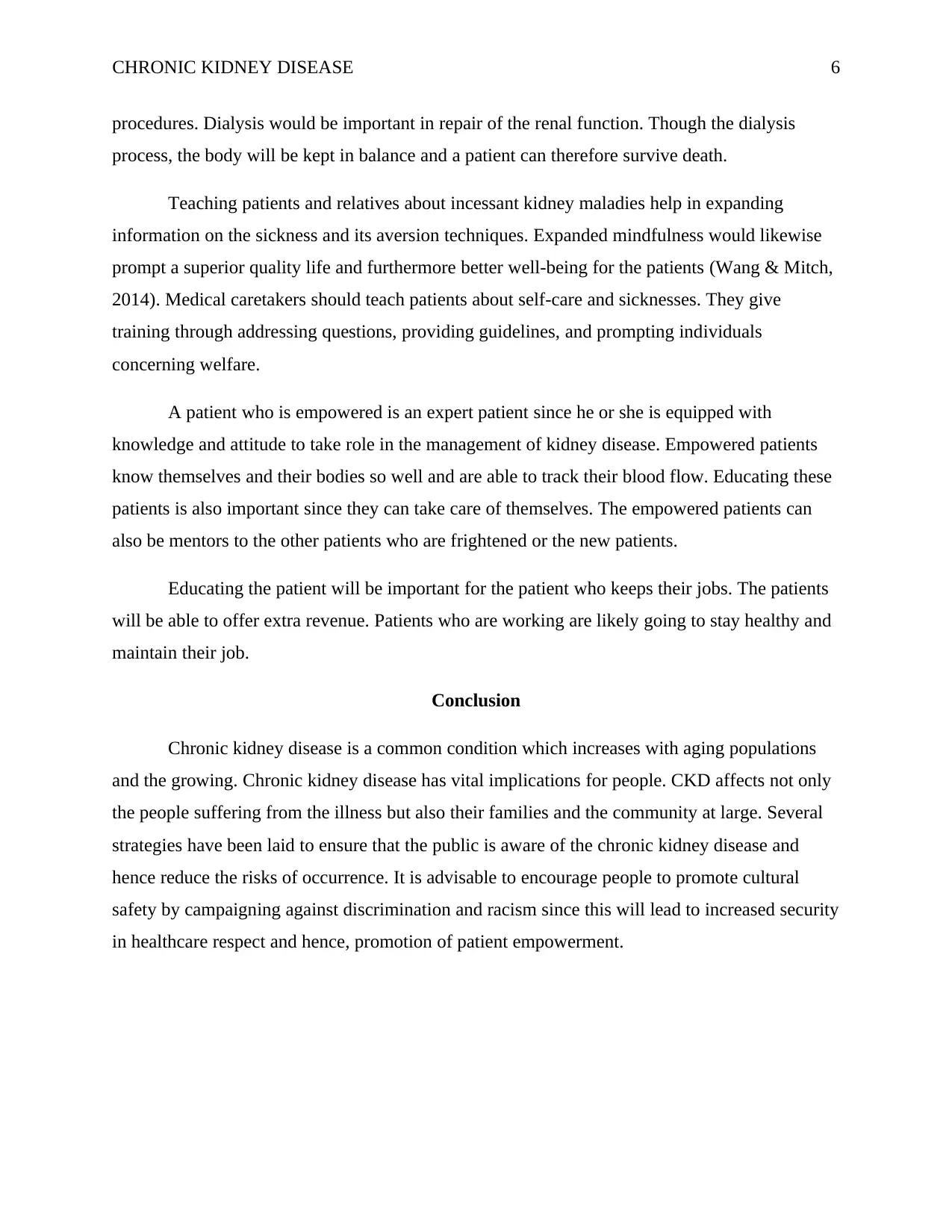
CHRONIC KIDNEY DISEASE 6
procedures. Dialysis would be important in repair of the renal function. Though the dialysis
process, the body will be kept in balance and a patient can therefore survive death.
Teaching patients and relatives about incessant kidney maladies help in expanding
information on the sickness and its aversion techniques. Expanded mindfulness would likewise
prompt a superior quality life and furthermore better well-being for the patients (Wang & Mitch,
2014). Medical caretakers should teach patients about self-care and sicknesses. They give
training through addressing questions, providing guidelines, and prompting individuals
concerning welfare.
A patient who is empowered is an expert patient since he or she is equipped with
knowledge and attitude to take role in the management of kidney disease. Empowered patients
know themselves and their bodies so well and are able to track their blood flow. Educating these
patients is also important since they can take care of themselves. The empowered patients can
also be mentors to the other patients who are frightened or the new patients.
Educating the patient will be important for the patient who keeps their jobs. The patients
will be able to offer extra revenue. Patients who are working are likely going to stay healthy and
maintain their job.
Conclusion
Chronic kidney disease is a common condition which increases with aging populations
and the growing. Chronic kidney disease has vital implications for people. CKD affects not only
the people suffering from the illness but also their families and the community at large. Several
strategies have been laid to ensure that the public is aware of the chronic kidney disease and
hence reduce the risks of occurrence. It is advisable to encourage people to promote cultural
safety by campaigning against discrimination and racism since this will lead to increased security
in healthcare respect and hence, promotion of patient empowerment.
procedures. Dialysis would be important in repair of the renal function. Though the dialysis
process, the body will be kept in balance and a patient can therefore survive death.
Teaching patients and relatives about incessant kidney maladies help in expanding
information on the sickness and its aversion techniques. Expanded mindfulness would likewise
prompt a superior quality life and furthermore better well-being for the patients (Wang & Mitch,
2014). Medical caretakers should teach patients about self-care and sicknesses. They give
training through addressing questions, providing guidelines, and prompting individuals
concerning welfare.
A patient who is empowered is an expert patient since he or she is equipped with
knowledge and attitude to take role in the management of kidney disease. Empowered patients
know themselves and their bodies so well and are able to track their blood flow. Educating these
patients is also important since they can take care of themselves. The empowered patients can
also be mentors to the other patients who are frightened or the new patients.
Educating the patient will be important for the patient who keeps their jobs. The patients
will be able to offer extra revenue. Patients who are working are likely going to stay healthy and
maintain their job.
Conclusion
Chronic kidney disease is a common condition which increases with aging populations
and the growing. Chronic kidney disease has vital implications for people. CKD affects not only
the people suffering from the illness but also their families and the community at large. Several
strategies have been laid to ensure that the public is aware of the chronic kidney disease and
hence reduce the risks of occurrence. It is advisable to encourage people to promote cultural
safety by campaigning against discrimination and racism since this will lead to increased security
in healthcare respect and hence, promotion of patient empowerment.
⊘ This is a preview!⊘
Do you want full access?
Subscribe today to unlock all pages.

Trusted by 1+ million students worldwide
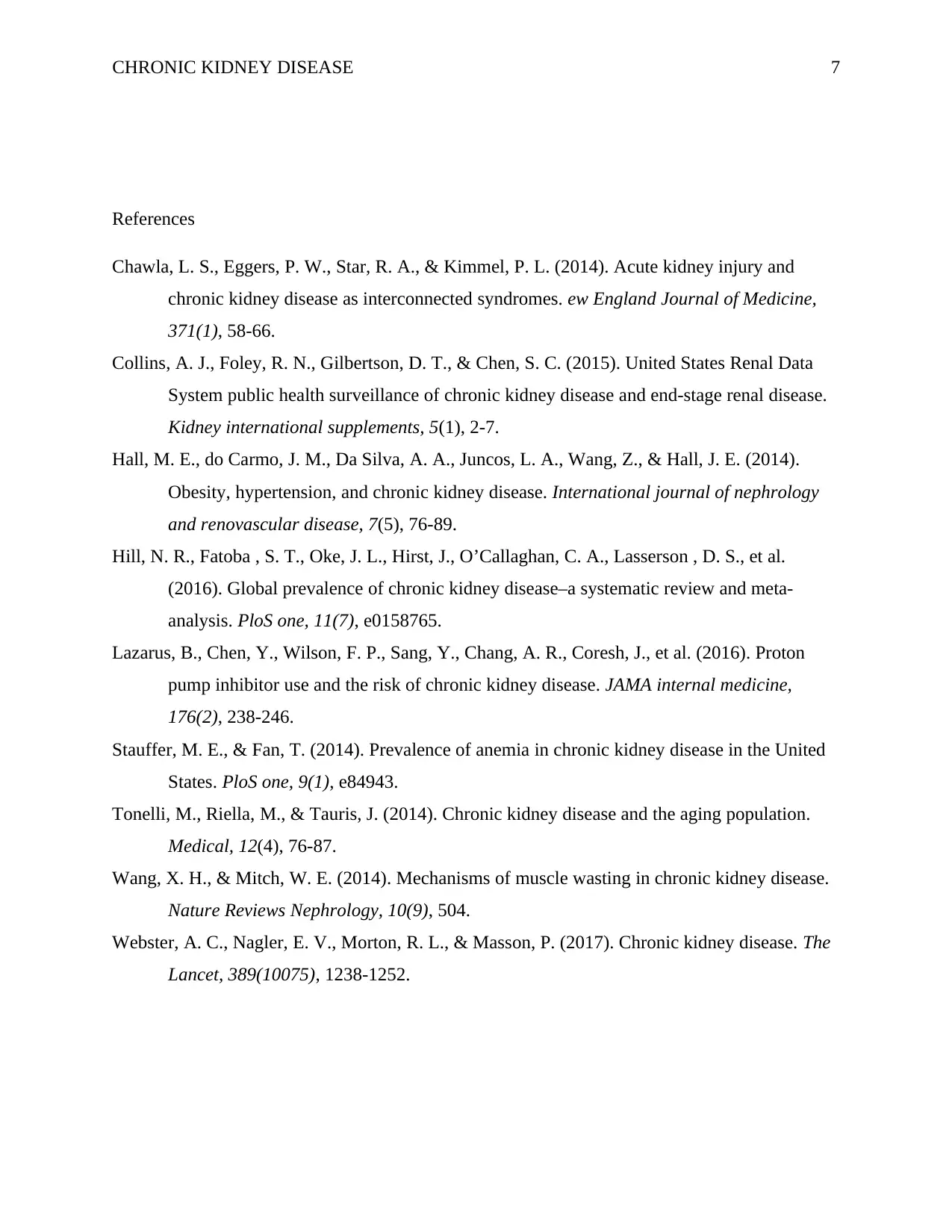
CHRONIC KIDNEY DISEASE 7
References
Chawla, L. S., Eggers, P. W., Star, R. A., & Kimmel, P. L. (2014). Acute kidney injury and
chronic kidney disease as interconnected syndromes. ew England Journal of Medicine,
371(1), 58-66.
Collins, A. J., Foley, R. N., Gilbertson, D. T., & Chen, S. C. (2015). United States Renal Data
System public health surveillance of chronic kidney disease and end-stage renal disease.
Kidney international supplements, 5(1), 2-7.
Hall, M. E., do Carmo, J. M., Da Silva, A. A., Juncos, L. A., Wang, Z., & Hall, J. E. (2014).
Obesity, hypertension, and chronic kidney disease. International journal of nephrology
and renovascular disease, 7(5), 76-89.
Hill, N. R., Fatoba , S. T., Oke, J. L., Hirst, J., O’Callaghan, C. A., Lasserson , D. S., et al.
(2016). Global prevalence of chronic kidney disease–a systematic review and meta-
analysis. PloS one, 11(7), e0158765.
Lazarus, B., Chen, Y., Wilson, F. P., Sang, Y., Chang, A. R., Coresh, J., et al. (2016). Proton
pump inhibitor use and the risk of chronic kidney disease. JAMA internal medicine,
176(2), 238-246.
Stauffer, M. E., & Fan, T. (2014). Prevalence of anemia in chronic kidney disease in the United
States. PloS one, 9(1), e84943.
Tonelli, M., Riella, M., & Tauris, J. (2014). Chronic kidney disease and the aging population.
Medical, 12(4), 76-87.
Wang, X. H., & Mitch, W. E. (2014). Mechanisms of muscle wasting in chronic kidney disease.
Nature Reviews Nephrology, 10(9), 504.
Webster, A. C., Nagler, E. V., Morton, R. L., & Masson, P. (2017). Chronic kidney disease. The
Lancet, 389(10075), 1238-1252.
References
Chawla, L. S., Eggers, P. W., Star, R. A., & Kimmel, P. L. (2014). Acute kidney injury and
chronic kidney disease as interconnected syndromes. ew England Journal of Medicine,
371(1), 58-66.
Collins, A. J., Foley, R. N., Gilbertson, D. T., & Chen, S. C. (2015). United States Renal Data
System public health surveillance of chronic kidney disease and end-stage renal disease.
Kidney international supplements, 5(1), 2-7.
Hall, M. E., do Carmo, J. M., Da Silva, A. A., Juncos, L. A., Wang, Z., & Hall, J. E. (2014).
Obesity, hypertension, and chronic kidney disease. International journal of nephrology
and renovascular disease, 7(5), 76-89.
Hill, N. R., Fatoba , S. T., Oke, J. L., Hirst, J., O’Callaghan, C. A., Lasserson , D. S., et al.
(2016). Global prevalence of chronic kidney disease–a systematic review and meta-
analysis. PloS one, 11(7), e0158765.
Lazarus, B., Chen, Y., Wilson, F. P., Sang, Y., Chang, A. R., Coresh, J., et al. (2016). Proton
pump inhibitor use and the risk of chronic kidney disease. JAMA internal medicine,
176(2), 238-246.
Stauffer, M. E., & Fan, T. (2014). Prevalence of anemia in chronic kidney disease in the United
States. PloS one, 9(1), e84943.
Tonelli, M., Riella, M., & Tauris, J. (2014). Chronic kidney disease and the aging population.
Medical, 12(4), 76-87.
Wang, X. H., & Mitch, W. E. (2014). Mechanisms of muscle wasting in chronic kidney disease.
Nature Reviews Nephrology, 10(9), 504.
Webster, A. C., Nagler, E. V., Morton, R. L., & Masson, P. (2017). Chronic kidney disease. The
Lancet, 389(10075), 1238-1252.
1 out of 7
Related Documents
Your All-in-One AI-Powered Toolkit for Academic Success.
+13062052269
info@desklib.com
Available 24*7 on WhatsApp / Email
![[object Object]](/_next/static/media/star-bottom.7253800d.svg)
Unlock your academic potential
Copyright © 2020–2025 A2Z Services. All Rights Reserved. Developed and managed by ZUCOL.





